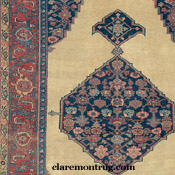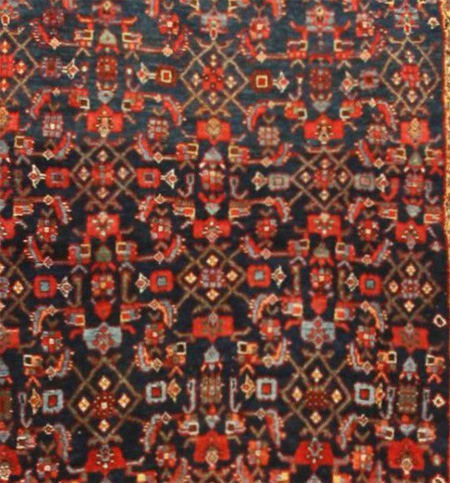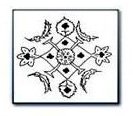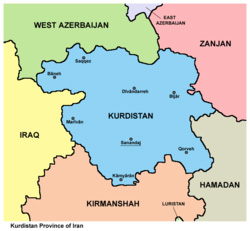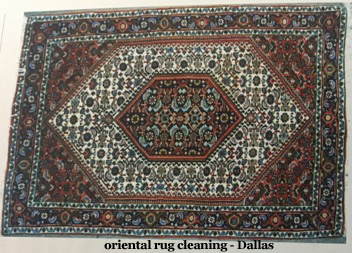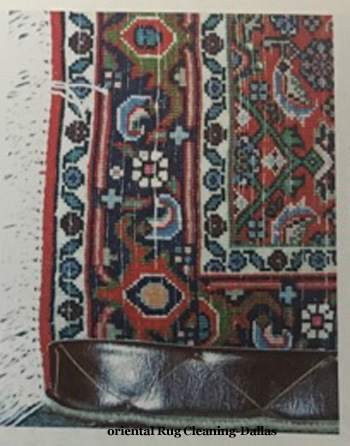THE BIJAR ORIENTAL RUG
The design of the Persian Bijar oriental rug is not as easily identified by the repetitive use of the same patterns as is the case with many of the other rugs.
The diversity in the range of designs in these rugs can be attributed to the many different tribes that call this region home, including the Azerbaijanis and the Turks, as well as the influence of nearby neighboring countries such as Turkey and areas in the Caucasus mountains.
Bijar designs are not as affected by Western design as other rugs woven in Iran partly because of the remoteness of the rural mountainous area and partly because the particular religion and culture of the people has effectively isolated them from the rest of Iran.
The antique Bijar (woven prior to 1915) used some classic universal rug designs such as the Mina Khani and the Herati, as well as a diamond-shaped center medallion with pendants on an open field. It is important to note these classic Persian designs were subject to the interpretation of the Bijar weavers, especially those from the Kurdish villages in the region.
The antique Bijar oriental rug is known for its excellent artistry, dyes, construction, and craftsmanship, while those made after WWII gradually lost their quality and unique individual characteristics and morphed into a generic product that bears little resemblance to its revered predecessor.
LOCATION OF BIJAR
Bijar is located in Northwestern Iran in the province of Kurdistan, approximately 150 miles south of Tabriz and 90 miles NW of Hamadan. The Bijar rugs were and are produced in the villages in the surrounding area. Kurdish tribes have been dominant in this region for centuries.
The name Bijar comes from the Kurdish 'Bi' meaning willow tree. An area of willow trees is called a 'Bijar.'
ANTIQUE BIJAR ORIENTAL RUG DISTINGUISHING FEATURE
What distinguishes the antique Bijar from other Persian rugs is its unique construction. Weavers used 2-3 wefts (foundation yarns inserted from side to side) between each row of knots. The first weft was much thicker than the second and was highly twisted. It was inserted while damp and then pounded tightly down with a hammer and a nail-like iron rod inserted between the warps, resulting in a highly compressed and durable rug.
It was this type of stout construction that earned the antique Bijar oriental rug the nickname of the 'iron rug of Persia' (Iran). The unique construction contributed to the extraordinary strength, coarseness, and weight of the rugs, making them very durable. In fact, they cannot and should not be folded and should always be rolled for storage or transporting.
MODERN BIJAR RUGS
In modern Bijar rugs, each weft is the same diameter but they are still a robust and dense product. The antique Bijars had wool for their warp and weft foundations, while the newer Bijars typically use cotton.
Bijars can be found in sizes ranging from 2x3 to 12x18 and larger. Bijar is also known for its small sampler rugs known as 'Wagirehs.' These are woven as a template for the production of larger rugs and incorporate the designs used in the borders and files of the rugs of the area.
DO YOU POSSESS A BIJAR ORIENTAL RUG?
As with all oriental rugs, a proper identification starts with a careful examination of the back of the rug in order to determine the materials and method of construction. This is especially important with the Bijar oriental rug. Because of their great diversity of design, looking at design only in these rugs will not always result in the correct identification.
If you have any questions about a particular rug, please feel free to call or text our office at 607-272-1566 or bring your rug in so we can help with identification and suggestions for cleaning and repair.
"The Cleanest Clean You've Ever Seen."
by
ABC Oriental Rug & Carpet Cleaning Co.
130 Cecil Malone Drive Ithaca, NY 14850
607-272-1566
Oriental and Area Rug Washing at ABC Oriental Rug
Rugs on the wash floor are gently scrubbed before thorough rinsing.
Gentle scrubbing continues. Note the wringer in the background-the next step in the washing process after rinsing.
After thorough rinsing, the rug is sent slowly and carefully through the wringer to take out as much of the water as possible before being hung on racks in the drying room.
Rugs are hung on a rack in the temperature controlled drying room until completely dry.
